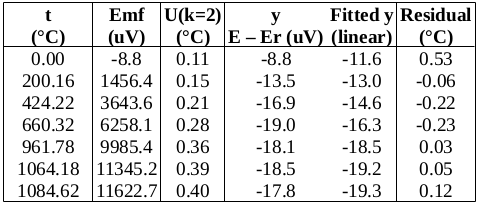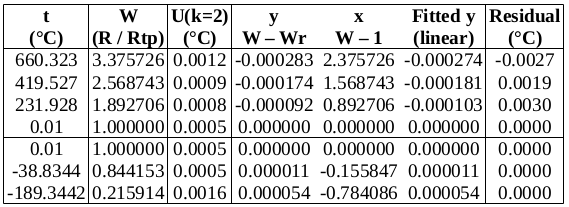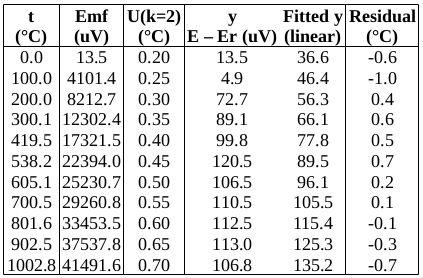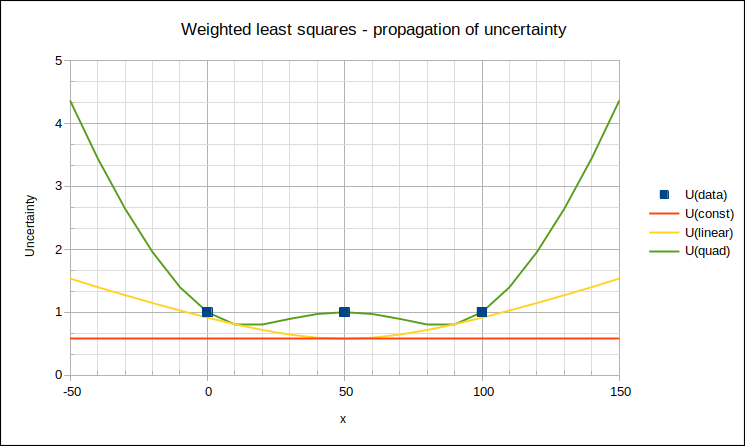Measuring instruments are often calibrated at relatively few points, but may be used at any point in the calibrated range. What is the calibration uncertainty at intermediate points? This article discusses some examples from Thermometry, using real calibration data for thermocouples and PRTs.
LIQUID-IN-GLASS THERMOMETERS
For liquid-in-glass thermometers, calibration every 50 to 100 scale divisions is considered adequate: “For thermometers not graduated above approximately 200 °C, it is generally accepted that the interval between test points should not exceed 100 scale divisions, if the corrected temperature values between the calibration points are to have an expected accuracy of approximately one-half of one scale division. If accuracies of one or two-tenths of a scale division are desired, it will be necessary to reduce the calibration interval to every 40 or 50 scale divisions. If a thermometer is graduated above 200 °C, a 40 to 50 scale division calibration interval is required to produce corrected temperature values with expected accuracies of approximately one-half of a scale division, and a 20 to 25 scale division calibration interval is necessary for expected accuracies to be approximately one or two-tenths of a scale division.” [Wise, “Liquid-in-Glass Thermometry”, NBS Monograph 150, 1976]
NOBLE-METAL THERMOCOUPLES & PRTS (ITS-90)
For “electrical” sensors such as resistance thermometers (RTDs) and thermocouples, the “quality” of the reference function (or reference tables) is often the important factor: If it represents any complex structure in the resistance or voltage vs temperature relationship well, then the deviation of a sensor from the reference function will be smooth and simple, requiring few calibration points, even over wide temperature ranges. For example, the 1993 NIST reference function for type R (Pt-Rh/Pt) thermocouples [Burns et al, NIST Monograph 175], reproduced in IEC 60584-1 of 1995 and 2013, is good enough to allow accuracies of (0.1 to 0.2) °C between calibration points several hundred degrees Celsius apart.


The ITS-90 PRT reference functions allow SPRT accuracy of 0.005 °C and IPRT accuracy of 0.02 °C between calibration points separated by several hundred degrees Celsius.


BASE-METAL THERMOCOUPLES & IPRTS (CALLENDAR-VAN DUSEN)
However, other sensors, such as the type K thermocouple, suffering from older (and less “refined”) reference functions and from temperature-induced drift, do not allow such accurate interpolation.

The above-mentioned IPRT, with deviations calculated against the simpler Callendar-van Dusen equations, now shows larger interpolation errors, up to 0.05 °C:

EXTRAPOLATION – GENERIC EXAMPLE
It is sometimes necessary to use a calibrated measuring instrument “slightly” outside its range of calibration, for example, using a thermometer at -1 °C that is calibrated from 0 to 100 °C. How far is it reasonable to extrapolate?: It depends on the type of sensor and on the range for which the sensor and associated electronics have been designed.
If either the sensor or the electronics is close to the limit of its operating range, “poor” behaviour (errors varying significantly more, and more rapidly, than in the middle of the range) may occur. We will consider the ideal case, where the behaviour of the sensor is well understood (and well modelled by the reference function being used) also beyond the point of interest, and the electronics is expected to behave consistently within and outside the calibrated range.

In this idealised example, there is no correlation between the three calibration points, all of which have an uncertainty of 1 at the calibration points 0, 50 and 100 (arbitrary units). Extrapolating 10% beyond the calibration range (to -10 or 110), the uncertainty of the quadratic curve increases to 1.4, so, in ideal conditions, it may be justifiable to extrapolate 10% beyond the calibration range and estimate the uncertainty there as 1.5 times the uncertainty within the range. (This very simplified analysis predicts an increase in uncertainty of 12.5% when extrapolating by 4% of range, which is comparable to the 20% increase reported by Nakano [Nakano & Tamura, “Extrapolation of the ITS-90 down to the boiling point of nitrogen from the triple point of argon”, J Phys Conf Series, 2018] when extrapolating to -196 °C from a -189 to 0 °C SPRT calibration.)
(Contact the author at LMC-Solutions.co.za.)